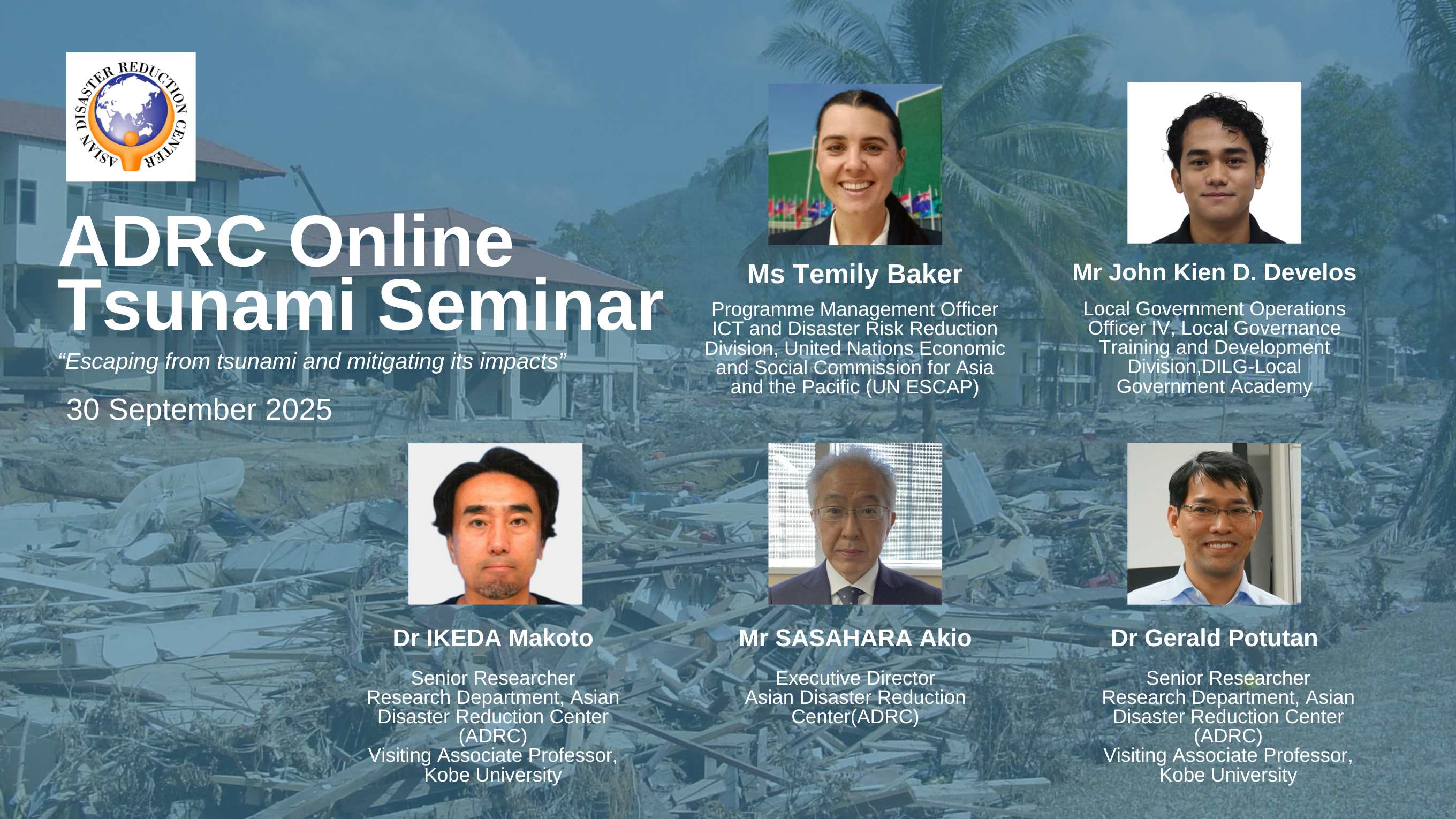Online Tsunami Seminar 2025

Background:
Tsunami disaster affects millions of people and incurs huge economic losses following the destruction of properties and infrastructures. Reducing risk from a tsunami disaster requires actions that are geared towards preparedness to escape from tsunami (e.g., relocation, early warning, education/awareness, drills, and evacuation routes/towers) and minimizing vulnerability through mitigation (e.g., tsunami walls, levees, elevated roads, and coastal forests).
Past experiences indicate that implementing key actions for tsunami DRR is disproportionately challenging in tsunami-prone countries. In Japan, aging population could make tsunami evacuation harder. In Bangladesh, the absence of tsunami early warning system could hamper evacuation efforts. In Indonesia, mitigation costs for constructing levees and seawalls hinder efforts to reducing vulnerability to tsunami.
Through sharing of information, experience, and technology on tsunami preparedness, those gaps and challenges can be addressed. For instance, through technology exchange in using artificial intelligence (AI) and big data, it is now faster to predict tsunamis, model risk more realistically, communicate warnings more effectively, and support evacuation planning more effectively.
Past experiences indicate that implementing key actions for tsunami DRR is disproportionately challenging in tsunami-prone countries. In Japan, aging population could make tsunami evacuation harder. In Bangladesh, the absence of tsunami early warning system could hamper evacuation efforts. In Indonesia, mitigation costs for constructing levees and seawalls hinder efforts to reducing vulnerability to tsunami.
Through sharing of information, experience, and technology on tsunami preparedness, those gaps and challenges can be addressed. For instance, through technology exchange in using artificial intelligence (AI) and big data, it is now faster to predict tsunamis, model risk more realistically, communicate warnings more effectively, and support evacuation planning more effectively.
Objectives:
- Provide information on recent development and guidance on preparedness and mitigation efforts for tsunami disasters in Asia-Pacific Region- Share case studies and experiences from tsunami impacted countries
- Discuss challenges, gaps, and issues in tsunami preparedness and mitigation
Expected Outcomes:
- Deeper perspective on what preparedness measures can be further promoted to effectively escape from tsunami or mitigate its impact- Greater understanding on the contributions of using new technologies (e.g., AI-supported) to address the gaps and challenges in tsunami preparedness efforts
- Gain practical insights on what is needed to sustain public engagement in tsunami preparedness and mitigation efforts
Agenda:
- 15:00 Introduction
- 15:05 Overview of Tsunami Preparedness within Multi-hazard Context
 (pdf, 2.1MB)
(pdf, 2.1MB)
by Ms Temily Baker, Programme Management Officer, ICT and Disaster Risk Reduction Division, United Nations Economic
and Social Commission for Asia and the Pacific (UN ESCAP)
- 15:20 Operation L!STO: Disaster Preparedness Manual for Tsunami
 (pdf, 2.4MB)
(pdf, 2.4MB)
by Mr John Kien D. Develos, Local Government Operations Officer IV, Local Governance Training and Development Division, DILG-Local Government Academy
- 15:35 DRR efforts at local level for the next Earthquake and Tsunami -Comparison between Japan and Indonesia-
 (pdf, 3.9MB)
(pdf, 3.9MB)
by Dr IKEDA Makoto, Senior Researcher, Research Department, Asian Disaster Reduction Center (ADRC), Visiting Associate Professor,
Kobe University
- 15:50 Discussions
- 16:10 Closing remarks & Wrap-up
- 16:15 End

Tsunami Seminar Secretariat:
Asian Disaster Reduction Center (ADRC)
1-5-2-5F Wakinohamakaigan-dori, Chuo-ku, Kobe 651-0073 JAPAN
TEL+81-78-262-5540/ FAX+81-78-262-5546
Mail: tsunamiseminar(at mark)adrc.asia
1-5-2-5F Wakinohamakaigan-dori, Chuo-ku, Kobe 651-0073 JAPAN
TEL+81-78-262-5540/ FAX+81-78-262-5546
Mail: tsunamiseminar(at mark)adrc.asia


